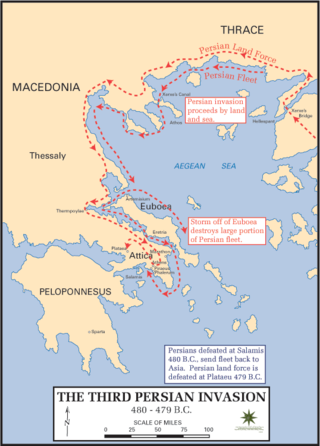The 4th century BCE started the first day of 400 BCE and ended the last day of 301 BCE. It is considered part of the Classical era, epoch, or historical period.

Year 323 BC was a year of the pre-Julian Roman calendar. At the time, it was known as the Year of the Consulship of Longus and Cerretanus. The denomination 323 BC for this year has been used since the early medieval period, when the Anno Domini calendar era became the prevalent method in Europe for naming years.

Year 342 BC was a year of the pre-Julian Roman calendar. At the time it was known as the Year of the Consulship of Ahala and Rutilus. The denomination 342 BC for this year has been used since the early medieval period, when the Anno Domini calendar era became the prevalent method in Europe for naming years.

Template:Reimprove
This article concerns the period 389 BC – 380 BC.

This article concerns the period 329 BC – 320 BC.
Year 335 BC was a year of the pre-Julian Roman calendar. At the time, it was known as the Year of the Consulship of Calenus and Corvus. The denomination 335 BC for this year has been used since the early medieval period, when the Anno Domini calendar era became the prevalent method in Europe for naming years.
The denomination 322 BC for this year has been used since the early medieval period, when the Anno Domini calendar era became the prevalent method in Europe for naming years.
Year 411 BC was a year of the pre-Julian Roman calendar. At the time, it was known as the Year of the Consulship of Mugillanus and Rutilus. The denomination 411 BC for this year has been used since the early medieval period, when the Anno Domini calendar era became the prevalent method in Europe for naming years.
Year 370 BC was a year of the pre-Julian Roman calendar. At the time, it was known as the Year of the Tribunate of Capitolinus, Medullinus, Praetextatus, Cornelius, Volusus and Poplicola. The denomination 370 BC for this year has been used since the early medieval period, when the Anno Domini calendar era became the prevalent method in Europe for naming years.
Year 367 BC was a year of the pre-Julian Roman calendar. At the time, it was known as the Year of the Tribunate of Cossus, Maluginensis, Macerinus, Capitolinus, Cicurinus and Poplicola. The denomination 367 BC for this year has been used since the early medieval period, when the Anno Domini calendar era became the prevalent method in Europe for naming years.

Paiania is a town and a municipality in East Attica, Greece. It is an eastern suburb of Athens, located east of Mount Hymettus. It is 11 km east of Athens city centre.
The Peripatetic school was a philosophical school founded in 335 BC by Aristotle in the Lyceum in Ancient Athens. It was an informal institution whose members conducted philosophical and scientific inquiries. After the middle of the 3rd century BC, the school fell into decline, and it was not until the Roman Empire that there was a revival.

Science in classical antiquity encompasses inquiries into the workings of the world or universe aimed at both practical goals as well as more abstract investigations belonging to natural philosophy. Classical antiquity is traditionally defined as the period between the 8th century BC and the 6th century AD. It is typically limited geographically to the Greco-Roman West, Mediterranean basin, and Ancient Near East, thus excluding traditions of science in the ancient world in regions such as China and the Indian subcontinent.
Callippus was a Greek astronomer and mathematician.

Ephebos, latinized as ephebus and anglicised as ephebe, is a term for a male adolescent in Ancient Greece. The term was particularly used to denote one who was doing military training and preparing to become an adult. From about 335 BC, ephebes from Athens underwent two years of military training under supervision, during which time they were exempt from civic duties and deprived of most civic rights. During the 3rd century BC, ephebic service ceased to be compulsory and its time was reduced to one year. By the 1st century BC, the ephebia became an institution reserved for wealthy individuals and, besides military training, it also included philosophic and literary studies.

Mieza, "shrine of the Nymphs", was a town in ancient Macedonia, where Aristotle taught the boy Alexander the Great between 343 and 340 BCE. Ptolemy classifies Mieza among the cities of Emathia. Stephanus of Byzantium, on the other hand, deriving his information apparently from Theagenes, alludes to it as "τόπος Στρυμόνος", and adds that it was sometimes called Strymonium. The site where Mieza once stood is the modern Lefkadia, near the modern town Náousa, Imathia, Central Macedonia, Greece, and has been the subject of archeological excavations since 1954.

Ipse dixit is an assertion without proof, or a dogmatic expression of opinion.

De Fato is a partially lost philosophical treatise written by the Roman orator Cicero in 44 BC. Only two-thirds of the work exists; the beginning and ending are missing. It takes the form of a dialogue, although it reads more like an exposition, whose interlocutors are Cicero and his friend Aulus Hirtius.
The Constitution of the Athenians, also called the Athenian Constitution, is a work by Aristotle or one of his students. The work describes the constitution of Athens. It is preserved on a papyrus roll from Hermopolis, published in 1891 and now in the British Library. A small part of the work also survives on two leaves of a papyrus codex, discovered in the Fayum in 1879 and now in the papyrus collection of the Egyptian Museum of Berlin.








